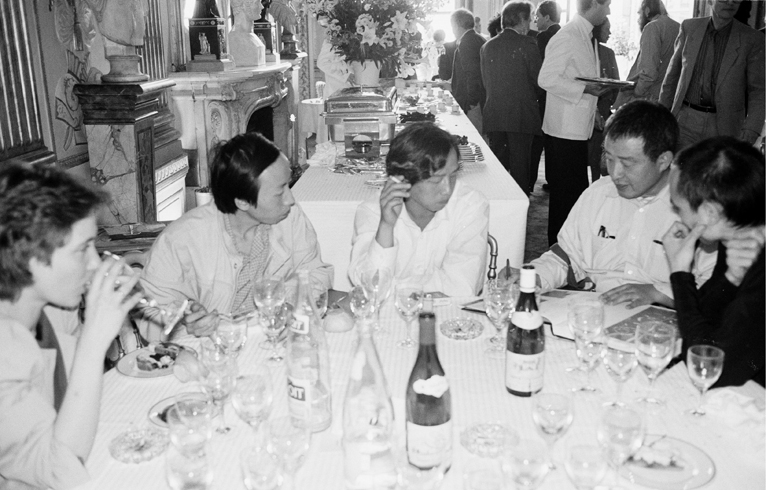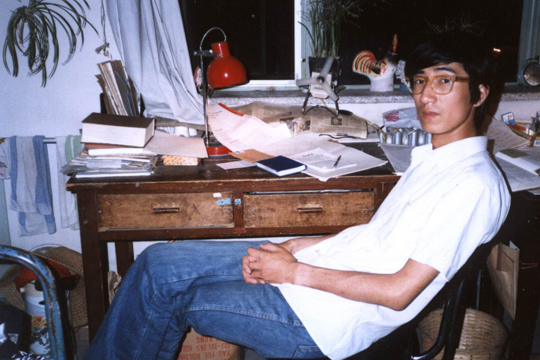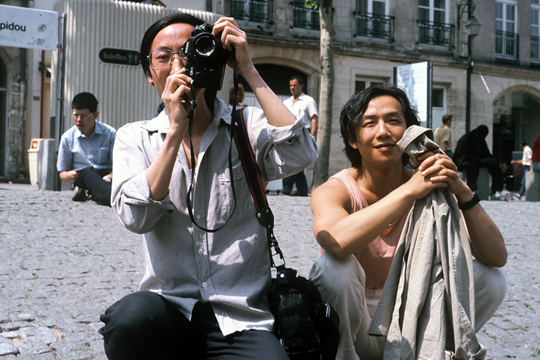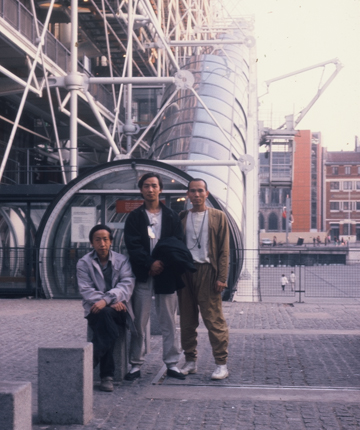ONCE UPON A CLOUD: OUR 1980s ART SCHOOL LIVES
| April 25, 2011 | Post In LEAP 8

I spent the 1970s in a factory. That decade, when I was between the ages of seventeen and twenty-seven, was an era severely lacking in books, but it was also the era during which I read the most. Every day after work, I buried myself in books, reading myself into states of both ecstasy and anguish. In our free time, my coworkers and I read about a hundred books each year, and we also took a lot of notes. These notes often included complete copies of books, made in fear that they would be forgotten. At 24, I began studying French in my factory. My coworkers and I were already enthusiastically reading novels in English without using dictionaries. All of this took place in a hopeless era. We had no idea about the impact these books would have on our futures, but we continued to throw ourselves into reading. Perhaps we were led by instinct to resist that closed-off era in the only way we could. And in books, we also found reasons for resistance. Those books allowed us to forget the reality around us. We were young, and we could exhaust ourselves by reading through the night, and then head to work the next day with blurry eyes. Most of these books we were reading were so-called banned books, and being caught would have meant inestimable danger. And at that age, the thrill of taking that risk was exactly what we needed most.
My individual fate was tied up in the fate of an entire generation. The end of the Cultural Revolution in 1976 changed the course of the lives of everyone in this generation. In 1981, giddy with excitement, I boarded a train to Beijing to take the first post-Cultural Revolution entrance examination for the Art History Department of the Central Academy of Fine Arts. Much to my surprise, I finished first in the nation on the test, putting an end to ten years of factory life. At the Central Academy of Fine Arts (CAFA), which I had not even dared to dream about, I met the “elite youth” of different parts of China, all full of vitality, and instructors with ardent and earnest looks in their eyes. In that gray, U-shaped building, the veins of one hundred years of Chinese art history quietly pulsed. Such an exceptional group of people assembling at such an exceptional time— was a great tempest brewing? Would a historical transition be shaped by our hands? I sensed that great change was on the horizon for me, and for the culture of the whole country.

In the 1980s, our world was full of contradictions. The beauty and ugliness of our old world were receding, and the ugliness and beauty of a new world beckoned. The interplay of these two worlds was surreal at times. Up in the clouds at the academy, we were involuntarily afflicted with schizophrenic tendencies, torn between urges to return to the past and progress toward the future. The leadership wanted to restore the “normal” art education system from before the Cultural Revolution and continue the Soviet art traditions of the past, but they shared their students’ avid curiosity about the newly accessible outside world. Could these two inclinations be unified, and if so, how? In the 1980s, the Zhejiang Academy of Fine Arts (today the China Academy of Art) began subscribing to hundreds of foreign art journals on behalf of its students and instructors. There were also dozens of these periodicals in the reading room at CAFA, where I was enrolled. This reading room was always packed with students, and the library was rapidly expanding. The academy held lecture after packed lecture introducing new worlds, ideas, and theories. A process of synchronization with the outside world had quietly begun.
Translation also reached a high tide in the 1980s. A century of Western art history, cultural history, and philosophy was being translated all at once into Chinese, completely overturning a world of minds that had been closed off for a long time. Who knew that the world could be thought about and described in these ways? The imaginations of young people were thoroughly activated. What is art? What is its significance? What is the essence of life? These abstract, metaphysical questions tormented the hordes of students at the academy, leaving them with unkempt appearances, glazed expressions, and poor diets. Stacks of philosophical treatises occupied their bedside tables, to the point that some people mumbled soliloquies on metaphysical topics even in their sleep.
Faced with students eagerly anticipating the future, education at the academy in the 1980s lagged far behind the times. CAFA’s leadership was more interested in figuring out how to encourage students to return to the rigid academic standards of the pre-Cultural Revolution academy. Members of the French, Soviet, and Yan’an factions, repressed during the Cultural Revolution, gradually returned to leadership positions in the academy. Every so often, the leadership would tearfully remind the students to treasure their golden opportunities, work hard to study technique, make contributions to the nation, and so on. Faced with the onslaught of modern art, the instructors maintained that the academy’s responsibility was to provide an educational foundation, and the main contents of this educational foundation was a “strong foundation in realism.” The educational spirit of the academy at the time is best captured by the maxim: “Only by achieving a strong foundation in sketching can one obtain artistic freedom.” This rhetorical balance between academicism and liberalism provides a typical reflection of the tactical approach adopted by academic education during that period of transition.

The academy was not an ivory tower. In the 1980s, the entire society, hesitant and tumultuous, was rapidly moving toward a more open world. “Only when we understand the outside world will we have the ability to criticize and resist it”— this was the tactical rhetoric adopted by young people and intellectuals in their search for openness. So although education in the classroom was conservative, the discussions and new ideas about art carried out in the academy were extremely dynamic. The lectures and the library provided alternatives to the standard educational offerings. The library maintained ample paid subscriptions to the newest overseas catalogues and specialized literature. At the time, CAFA had only 200-odd students (they were outnumbered by their instructors), but the handful of lectures each week were always overcrowded. I still remember, after a lecture I gave on the philosophy of Henri Bergson, how a classmate complained to me that I had drawn so many people that he had to stand on his toes behind a crowd in the doorway, craning his neck for a full two hours. I was the “Vice Chair” of the Young Teachers Association, and I was responsible for planning lectures in the academy’s large lecture hall. There was basically no approval required for the content of the lectures. Zhang Yimou, Gong Li, Tan Dun, and Yung Ho Chang were among those who came to speak at my invitation.
There were only ten students in my undergraduate art history cohort, the first after the academy’s reopening, and each of us was provided with a big desk and a big armchair more or less equivalent to what bureau-level cadres used at that time. During classes, we were allowed to brew a big cup of tea on our desks. The lectern was quite small, and to us, the instructors’ lectures were like so many brilliant television programs of differing character. Each instructor had his or her own style. The Hermitage Museum seemed to always loom imposingly behind Shao Dazhen, in sharp contrast to the pedantic air of Xue Yongnian. Tang Chi’s passion for archeology, and his pet phrase— “I happened to be there at the time”— were widely popular among the students. It seemed that Chang Youming’s lectures on the history of Dutch painting were given solely for my benefit, because as he gave them, he would always look straight at me.

Our curriculum was quite comprehensive: “History of Chinese Art,” “History of Western Art,” and “Art Theory” were the three main components, and we had three years of each. “History of Western Art” continued up to the Pop Art of the 1970s, which counted as quite “advanced” in comparison to art history educations in other countries at the time. Our instructors encouraged us to view history through the lens of dialectical materialism, but we were permitted to research whichever topics interested us. The instructors required only that we write logically sound, structurally rigid papers that presented tenable and defensible arguments. I wrote my thesis on Bergson’s aesthetics; a classmate chose the topic of gestalt psychology. These topics went far beyond the scope of the art history curriculum, and at the time, they approached the fringes of acceptable politics. The approval of these theses demonstrated progress in the opening up of the academy.
In contrast to the art history department, relations between instructors and students were noticeably strained in the oil painting department. Due to the heavy influx of information about modern art from the outside, there was no lack of students interested in experimenting with new artistic ideas. But those who dared to directly confront the academic approach to art in their in-class experimentation were seen as traitors, and in the most severe cases, students were expelled. The expulsion of Lin Lin, then a talented student, from the Zhejiang Academy is just one example.
Another important justification for the strict educational approach was the employment problem faced by graduates. At that time, instructors and school leaders directly participated in the allocation of work opportunities for new graduates. Those students who did not ardently study realism ran the risk of being assigned to undesirable work units outside of major cities and even to remote frontiers. Huang Yong Ping, a classmate of Lin Lin’s, was sent to Xiamen to teach art to middle school students because of his pursuit of modern art.
The contradictions and peculiarities of academic education produced two direct consequences: first, students had to wait until after graduation to find work, and then wait further, until a critical mass of graduates had emerged, before uniting to launch a rebellion in the art world; and second, all of these rebels had strong foundations in sketching. This explains why the ’85 Movement took place in 1985 and not earlier. It also explains why many of the artists in the ’85 Movement were adept at applying the techniques of realism to express ideas, and why the Xiamen Dada, which Huang Yong Ping founded while teaching middle school, repeatedly clamored for the death of painting. These early 1980s graduates of art academies were the driving force behind the ’85 Movement, and they mounted a major attack on the history of Chinese contemporary art. This was, in fact, a real consequence of their academic educations!
I deeply loved the inconvenient, dusty Beijing of those years, and I loved our chaotic lives as students. We bore witness as a suppressed history rose forth from cracks in the earth and formed a fog that spread through the air. It was as if we had all heard the same call: A new era is coming soon! What is it? What is it!

